
In patients with asthma, the typical asthma symptoms of chest tightness, coughing, wheezing, and/or shortness of breath may be aggravated if the underlying acid reflux is not treated appropriately. The first way this may occur is via small amounts of acid irritating the airways (similar to a chemical burn) which may in turn cause asthma symptoms. The second method may involve the triggering of a reflex in the airways to become narrower in order to prevent more acid from entering the airways. It is this narrowing of the airways that causes an individual with asthma to cough, wheeze, cough, experience chest tightness and/or feel short of breath.
In addition to the 2 methods above, some asthma medications may decrease the lower esophageal sphincter pressure thus relaxing this muscle which in turn will increase the severity of GERD or acid reflux. Asthma medications in the bronchodilator family such as albuterol (i.e., Proventil, ProAir, Ventolin, AccuNeb), terbutaline (i.e., Brethaire, Brethine), vilanterol, ipatroprium (i.e., Atrovent), salmeterol (i.e., Serevent), formoterol, (i.e., Foradil), levalbuterol (i.e., Xopenex), and Tiotropium (i.e., Spiriva) fall into this category. There are also asthma medications that are combinations of two or more medications, one of which is a bronchodilator, which can therefore increase acid reflux disease. The names of some of these medications include Advair, Dulera, Breo Ellipta, Symbicort, Combivent, AIRSUPRA, Trelegy, and DuoNeb. Theophylline (i.e., Theo-Dur, Uniphyl, Slo-Bid, Theo-24), an older but still useful oral bronchodilator asthma medication, has also been associated with an increase in GERD in patients by causing the relaxation of the lower esophageal sphincter as well. Interestingly, the chemical structure of theophylline is similar to that of caffeine which is another trigger of GERD.
It is a double edge sword because not only can acid reflux exacerbate one’s asthma, but asthma can also make one’s acid reflux worse. In addition to asthma making one’s acid reflux worse, there are several risk factors that may contribute to GERD and some of them may include obesity, alcohol use, diabetes mellitus, pregnancy, smoking, connective tissue diseases (e.g., systemic sclerosis or scleroderma), eating large meals, eating before bed, hiatal hernia, certain medications , and/or certain foods .
The diagnosis of GERD can be made by performing a comprehensive history from the patient along with observing relief when taking anti-reflux medications such as antacids and/or acid-blocking medications. If there is no improvement in acid reflux symptoms, there are several procedures that can be performed in order to help establish the diagnosis of acid reflux disease. Some of these procedures include upper endoscopy with or without a biopsy, barium swallow, pH monitoring (checks the acidity in the stomach), and esophageal manometry (checks the function of the lower esophageal sphincter and esophagus).
The treatment of GERD is directed at reducing the risk factors mentioned above as well as prescribing acid-blocking medications and antacids. By treating the underlying GERD in patients who are asthmatic with associated GERD, the symptoms of asthma (i.e., chest tightness, coughing, wheezing, and shortness of breath) may also be reduced.
The board certified allergy doctors at Black & Kletz Allergy have been diagnosing and treating asthma for more than 50 years. We treat both pediatric and adult and patients. Black & Kletz Allergy has offices in Washington, DC, McLean, VA (Tysons Corner, VA), and Manassas, VA. All 3 of our offices have on-site parking. For further convenience, our Washington, DC and McLean, VA offices are Metro accessible. Our McLean office location offers a complementary shuttle that runs between our office and the Spring Hill metro station on the silver line. For an appointment, please call our office or alternatively, you can click Request an Appointment and we will respond within 24 hours by the next business day. If you suffer from asthma or allergies, we are here to help relieve or hopefully end these undesirable symptoms that have been so bothersome, so that you can enjoy a better quality of life. Black & Kletz Allergy is dedicated to providing the highest quality allergy care in a calm, compassionate, and professional environment.


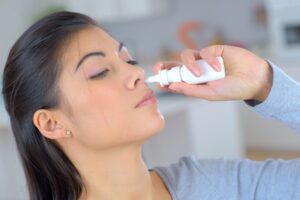 SARS-CoV-2 is the name of the coronavirus that is responsible for the COVID-19 pandemic that caused millions of deaths worldwide. Although vaccination and established population immunity have substantially mitigated the severity of acute SARS-CoV-2 infections, the virus continues to infect millions of people resulting in a number of hospitalizations and deaths. There is a need for an effective pre-exposure prophylaxis for the general population, particularly for high-risk groups such as individuals with preexisting conditions and the elderly.
SARS-CoV-2 is the name of the coronavirus that is responsible for the COVID-19 pandemic that caused millions of deaths worldwide. Although vaccination and established population immunity have substantially mitigated the severity of acute SARS-CoV-2 infections, the virus continues to infect millions of people resulting in a number of hospitalizations and deaths. There is a need for an effective pre-exposure prophylaxis for the general population, particularly for high-risk groups such as individuals with preexisting conditions and the elderly.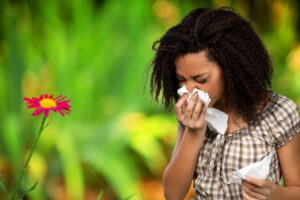 Autumn has just begun and for some people it is a bittersweet moment. Although many individuals enjoy the lower temperatures that the autumn brings in the
Autumn has just begun and for some people it is a bittersweet moment. Although many individuals enjoy the lower temperatures that the autumn brings in the 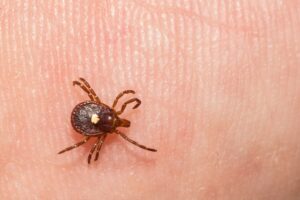
 Over the last 10-15 years, the number of individuals with meat allergy has risen mainly because of a condition called alpha-gal syndrome or mammalian meat allergy. Alpha-gal syndrome was first identified by Dr. Thomas Platts-Mills at the University of Virginia School of Medicine in 2002. He discovered that the syndrome originated from the bite of lone star ticks (Amblyomma americanum). Specifically, the IgE antibody (i.e., the allergy antibody) response to the mammalian sugar molecule known as alpha-gal was associated with a delayed-onset swelling (i.e., angioedema) and/or anaphylaxis 2 to 8 hours after eating mammalian food products, such as beef, lamb, pork, and/or venison.
Over the last 10-15 years, the number of individuals with meat allergy has risen mainly because of a condition called alpha-gal syndrome or mammalian meat allergy. Alpha-gal syndrome was first identified by Dr. Thomas Platts-Mills at the University of Virginia School of Medicine in 2002. He discovered that the syndrome originated from the bite of lone star ticks (Amblyomma americanum). Specifically, the IgE antibody (i.e., the allergy antibody) response to the mammalian sugar molecule known as alpha-gal was associated with a delayed-onset swelling (i.e., angioedema) and/or anaphylaxis 2 to 8 hours after eating mammalian food products, such as beef, lamb, pork, and/or venison.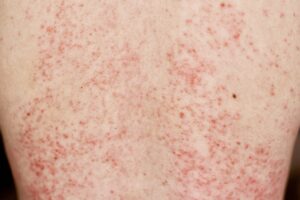 Toxic epidermal necrolysis (TEN) is a painful, life-threatening skin condition. It is associated with blistering and peeling of large areas of the skin, including mucous membranes such as the mouth, eyes, and/or genitals. If less than 10% of the body surface is involved, it is often called Stevens- Johnson syndrome (SJS).
Toxic epidermal necrolysis (TEN) is a painful, life-threatening skin condition. It is associated with blistering and peeling of large areas of the skin, including mucous membranes such as the mouth, eyes, and/or genitals. If less than 10% of the body surface is involved, it is often called Stevens- Johnson syndrome (SJS).  Pet allergies are quite common in the United States. About 20% of the U.S. population have cat allergies and 10% of the people in the U.S. have dog allergies. Approximately 70% of the homes in the U.S. have at least 1 pet with dogs being the most common pet, followed by cats. The percentage of homes with pets is higher than in the past as more and more families are getting pets. The Labrador Retriever is the most common pet dog and the Ragdoll is the most common pet cat. There are roughly 77 million pet dogs living in the U.S, however there are only 49 million households with dogs. In other words, each dog-owning home has an average of 1.5 dogs. In contrast, there are roughly 59 million cats living in approximately 32 million homes, which is equivalent to 1.8 cats per household.
Pet allergies are quite common in the United States. About 20% of the U.S. population have cat allergies and 10% of the people in the U.S. have dog allergies. Approximately 70% of the homes in the U.S. have at least 1 pet with dogs being the most common pet, followed by cats. The percentage of homes with pets is higher than in the past as more and more families are getting pets. The Labrador Retriever is the most common pet dog and the Ragdoll is the most common pet cat. There are roughly 77 million pet dogs living in the U.S, however there are only 49 million households with dogs. In other words, each dog-owning home has an average of 1.5 dogs. In contrast, there are roughly 59 million cats living in approximately 32 million homes, which is equivalent to 1.8 cats per household.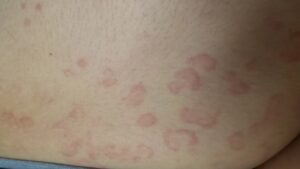 Erythema Multiforme is a type of a rash on the skin, usually triggered by an infection or an adverse effect of a medication. The condition gets its name from the appearance of reddish skin lesions of various forms seen at the same time.
Erythema Multiforme is a type of a rash on the skin, usually triggered by an infection or an adverse effect of a medication. The condition gets its name from the appearance of reddish skin lesions of various forms seen at the same time.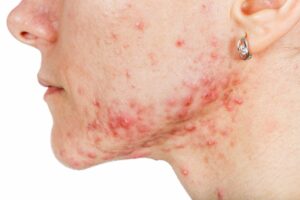 Prurigo nodularis is a chronic inflammatory skin disease where an extremely itchy rash in the form of firm bumps called nodules appears most commonly on the arms, legs, upper back, and/or abdomen. The rash is usually symmetrically distributed on both sides of the body. The itchiness, burning, and stinging sensation associated with prurigo nodularis is so severe that it often interferes with sleep and one’s psychological well-being.
Prurigo nodularis is a chronic inflammatory skin disease where an extremely itchy rash in the form of firm bumps called nodules appears most commonly on the arms, legs, upper back, and/or abdomen. The rash is usually symmetrically distributed on both sides of the body. The itchiness, burning, and stinging sensation associated with prurigo nodularis is so severe that it often interferes with sleep and one’s psychological well-being. Now that Summer is almost here, people tend to spend a lot of time outdoors. Whether it be going to the beach, swimming at the neighborhood pool, playing baseball or softball, having a picnic, fishing, hiking, riding bicycles, gardening, or any other outside activity, people are more likely to be outdoors now than in any other season of the year. Since the general public is outdoors more in the Summers, it should be noted that there are a lot of outdoor allergens that they are being exposed to when outside.
Now that Summer is almost here, people tend to spend a lot of time outdoors. Whether it be going to the beach, swimming at the neighborhood pool, playing baseball or softball, having a picnic, fishing, hiking, riding bicycles, gardening, or any other outside activity, people are more likely to be outdoors now than in any other season of the year. Since the general public is outdoors more in the Summers, it should be noted that there are a lot of outdoor allergens that they are being exposed to when outside. Histamine is a biogenic amine (i.e., an
Histamine is a biogenic amine (i.e., an  Individuals with pollen allergies may be affected throughout the year, depending on where they live or travel. In the
Individuals with pollen allergies may be affected throughout the year, depending on where they live or travel. In the 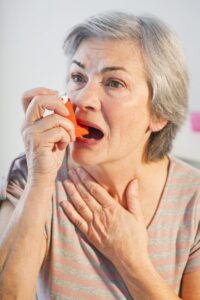 Although Primatene Mist became available in 1967, the FDA took it off the market in 2011, as it contained propellants called chlorofluorocarbons (CFC’s) which are harmful to the environment as they deplete ozone from the atmosphere. However, Primatene mist was recently reintroduced into the market with a newer propellant called hydrofluoroalkanes (HFA’s), which are environment friendly. Primatene Mist temporarily opens up the airways in the lungs thus offering a very short-term relief from shortness of breath and/or wheezing. It is approved only for individuals with an established prior diagnosis of asthma. It is used for the temporary relief of mild symptoms of intermittent asthma in patients aged 12 years or older and should not be used as a replacement for prescription asthma medications. Primatene Mist can do more harm than good if used for a chronic cough, for instance, without a known cause.
Although Primatene Mist became available in 1967, the FDA took it off the market in 2011, as it contained propellants called chlorofluorocarbons (CFC’s) which are harmful to the environment as they deplete ozone from the atmosphere. However, Primatene mist was recently reintroduced into the market with a newer propellant called hydrofluoroalkanes (HFA’s), which are environment friendly. Primatene Mist temporarily opens up the airways in the lungs thus offering a very short-term relief from shortness of breath and/or wheezing. It is approved only for individuals with an established prior diagnosis of asthma. It is used for the temporary relief of mild symptoms of intermittent asthma in patients aged 12 years or older and should not be used as a replacement for prescription asthma medications. Primatene Mist can do more harm than good if used for a chronic cough, for instance, without a known cause. Pollen food allergy syndrome (PFAS), also known as oral allergy syndrome, is a condition in which there is first a “sensitization” of the immune system to various pollens and subsequent “reactions” when exposed to these pollens. Secondly, there is a similarity of the protein allergens in the pollen and the protein allergens of certain raw or fresh fruits and/or vegetables. The individual’s immune system, which has been previously sensitized to pollen, will also react to the similarly structured proteins in the raw or fresh fruits and/or vegetables. As a result, when a person who has a pollen allergy (usually trees and/or weeds) eats certain raw or fresh fruits and/or vegetables, that individual’s immune system “thinks” that it is being exposed to pollen proteins when in fact it is being exposed to fruit and/or vegetable proteins that have a very similar chemical structure to the pollen proteins. The body in turn reacts to the fresh fruit and/or vegetable proteins in a similar fashion as a typical allergic reaction but is usually more localized to where the food makes direct contact, such as the lips, tongue, palate, ears, gums, and/or throat. Essentially, there is a cross-reaction to the fresh fruit and/or vegetable because that food is mistaken for pollen and thus reacts in a similar way except the reaction is mostly where contact occurs between the food and the mouth. Note that if the fruit or vegetable is cooked, the pollen food allergy reaction does not usually take place because the heating of the fruit and/or vegetable denatures the protein resulting in the immune system not recognizing this denatured protein anymore because the altered structure of the protein does not look like the pollen protein (allergen) anymore.
Pollen food allergy syndrome (PFAS), also known as oral allergy syndrome, is a condition in which there is first a “sensitization” of the immune system to various pollens and subsequent “reactions” when exposed to these pollens. Secondly, there is a similarity of the protein allergens in the pollen and the protein allergens of certain raw or fresh fruits and/or vegetables. The individual’s immune system, which has been previously sensitized to pollen, will also react to the similarly structured proteins in the raw or fresh fruits and/or vegetables. As a result, when a person who has a pollen allergy (usually trees and/or weeds) eats certain raw or fresh fruits and/or vegetables, that individual’s immune system “thinks” that it is being exposed to pollen proteins when in fact it is being exposed to fruit and/or vegetable proteins that have a very similar chemical structure to the pollen proteins. The body in turn reacts to the fresh fruit and/or vegetable proteins in a similar fashion as a typical allergic reaction but is usually more localized to where the food makes direct contact, such as the lips, tongue, palate, ears, gums, and/or throat. Essentially, there is a cross-reaction to the fresh fruit and/or vegetable because that food is mistaken for pollen and thus reacts in a similar way except the reaction is mostly where contact occurs between the food and the mouth. Note that if the fruit or vegetable is cooked, the pollen food allergy reaction does not usually take place because the heating of the fruit and/or vegetable denatures the protein resulting in the immune system not recognizing this denatured protein anymore because the altered structure of the protein does not look like the pollen protein (allergen) anymore. Spring is here! This means that quite a few Washingtonians will be pretty miserable as they will be suffering from
Spring is here! This means that quite a few Washingtonians will be pretty miserable as they will be suffering from  Food protein-induced enterocolitis syndrome (FPIES) is a rare condition that causes gastrointestinal symptoms several hours after consumption of certain foods by an individual who has an intolerance to that food. The prevalence rate in the United States is approximately 0.5%. The most common types of food allergy in children and adults are mediated by an antibody called IgE. Food allergies may result in adverse reactions which in some cases may be very severe and even life-threatening in some that may occur within minutes of ingestion of the offending food. The IgE antibodies are specific to the food that causes the reaction.
Food protein-induced enterocolitis syndrome (FPIES) is a rare condition that causes gastrointestinal symptoms several hours after consumption of certain foods by an individual who has an intolerance to that food. The prevalence rate in the United States is approximately 0.5%. The most common types of food allergy in children and adults are mediated by an antibody called IgE. Food allergies may result in adverse reactions which in some cases may be very severe and even life-threatening in some that may occur within minutes of ingestion of the offending food. The IgE antibodies are specific to the food that causes the reaction. 









